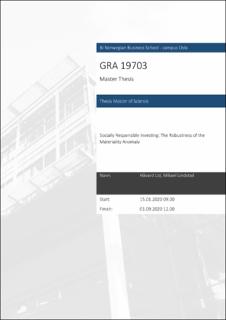| dc.contributor.author | Lid, Håvard | |
| dc.contributor.author | Lindstad, Mikael | |
| dc.date.accessioned | 2020-11-16T09:30:24Z | |
| dc.date.available | 2020-11-16T09:30:24Z | |
| dc.date.issued | 2020 | |
| dc.identifier.uri | https://hdl.handle.net/11250/2687969 | |
| dc.description | Masteroppgave(MSc) in Master of Science in Finance - Handelshøyskolen BI, 2020/Masteroppgave(MSc) in Master of Science in Business - QTEM Masters Networks - Handelshøyskolen BI, 2020 | en_US |
| dc.description.abstract | In this paper we investigate the nancial performance implications
of rms' commitment to sustainability e orts. We evaluate three
possible explanations for the abnormal returns identi ed in portfolios
constructed on the basis of material CSR-scores; traditional
risk factors, an underlying "saint" factor, or asymmetric market
information prior to materiality considerations becoming publicly
available. We nd that abnormal returns only occur in portfolios
based on sector adjusted material score change, and these returns
can be fully accounted for by common risk factors, speci cally the
Fama and French (2015) ve-factor model. Our results suggest
that the risk-adjusted performance of rms highly committed to
sustainability measures is insigni cantly di erent from rms less
committed to social responsibility, regardless of materiality classi-
cations used to evaluate CSR performance. | en_US |
| dc.language.iso | eng | en_US |
| dc.publisher | Handelshøyskolen BI | en_US |
| dc.subject | financial economics | en_US |
| dc.subject | finans | en_US |
| dc.subject | finance | en_US |
| dc.subject | business | |
| dc.title | Socially Responsible Investing: The Robustness of the Materiality Anomaly | en_US |
| dc.type | Master thesis | en_US |
